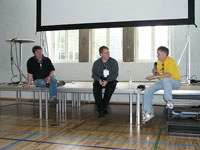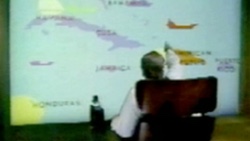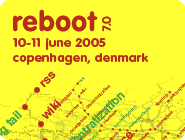 reboot 7.0 – trip report
reboot 7.0 – trip report
10-11 June 2005 in Copenhagen, Denmark
Friday, 10 June 2005

Full program available at reboot7: topics. This page contains abstracts (left) and notes (right) of the sessions I attended.
 400 people from more than 20 countries attended this year’s reboot conference in Copenhagen. It was the first time the conference language was English – good for me ’cause my Danish is not very well developed.
400 people from more than 20 countries attended this year’s reboot conference in Copenhagen. It was the first time the conference language was English – good for me ’cause my Danish is not very well developed.
Conference venue was an old kettle heating central just renovated with three great big lofty rooms. A perfect spot for that kind of event.
Reframing the Net
Doc SearlsWe use at four different metaphors to frame our understanding of the Net and the Web. Two of the four describe a world open to free speech and free enterprise. The other two describe a closed plumbing system designed to protect copyright absolutists. Doc describes how we can reboot our vocabularies to favor the former and prevent the latter.
*** (my rating: 3 stars out of 3)
 Doc is coauthor of The Cluetrain Manifesto
Doc is coauthor of The Cluetrain ManifestoWhy blogs matter
Robert Scoble
The emerging field of collaborative citizen journalism, making a business out of blogging, and why blogs matter.
*
 Microsoft’s famous blogger
Microsoft’s famous bloggerOpen Source Design, Lessons from the Kubrick template
Michael HeilemannOriginally released for wordpress it has now been “ported” to most other blog tools and have been enhanced and resampled by the users. The question is whether Open Source is coming to design?
**
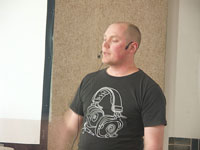 Michael is the creator of the Kubrick template, a user interface for blogs. Sharing his design work made him not rich, but happy!
Michael is the creator of the Kubrick template, a user interface for blogs. Sharing his design work made him not rich, but happy!Social Tools for Research and Collaboration
Dina MehtaHow to use blogs and other tools for research and innovation, and examples of collaborative projects between ‘physically’ remote teams. Examples from the tsunamihelp blog and other team blogs set up during the course of ethnographic research projects, and the potential for blogs as a research tool.
**
 Dina is passionate about the use of blogs and wikis. They are fast, inexpensive, and in case of catastrophic disasters they can guide help and support to places where it is needed most.
Dina is passionate about the use of blogs and wikis. They are fast, inexpensive, and in case of catastrophic disasters they can guide help and support to places where it is needed most.
Blogs and wikis are also well suited tools to support corporate teams distributed across continents and time zones.
MySQL
At Play in the Garden
Ben CervenyInteraction and information designers are struggling to provide accessible strategies for comprehending and manipulating the ever-more complex flow of datastreams around us. It turns out that nature provides both behavioral and structural mechanisms to aid us in that task: the instinct towards play and the comprehensible complexity of organic forms.
***
 Ben made the distinction between game and play. A game has strict rules and a winner and a loser. On the other hand a play provokes no competition. It is a much better paradigm for computer systems than games are.
Ben made the distinction between game and play. A game has strict rules and a winner and a loser. On the other hand a play provokes no competition. It is a much better paradigm for computer systems than games are.The Intelligence of Wikipedia
Jimbo WalesSome people believe that Wikipedia is an example of “swarm intelligence” but Jimmy Wales will explain how Wikipedia is actually much more traditional than usually recognized. Wikipedia is a social community operating with human judgment, as opposed to random interaction of millions of people.
***
 Jimmy is director of wikipedia. He talked about contributors, legal aspects, quality issues, and decision making processes within the wikipedia community.
Jimmy is director of wikipedia. He talked about contributors, legal aspects, quality issues, and decision making processes within the wikipedia community.
Lessons From Cooper Interaction Design
Anders Bertram EibyeCoopers Personas and Goal Directed Design methods demystified. Sharing experiences from working within a well defined design framework, and an inside look at the hidden features of a strong and communicative method.
*
a talk about personas – well not quite – a talk by a guy who worked at Cooper Interaction for some time and who is convinced by the personas concepts.I suppose the approach is the right one. But Andreas had no new insights for us.
Back to the Future – The Way to a Personal Dynamic Medium for Creative Thought
Matthias Müller-ProveLooking into the long history of hypertext and graphical user interfaces reveals fascinating insights that might help build a computer environment that really propels us into the future.
no rating applicable
 My own presentation on the history of hypertext and GUIs was well received. Maybe 70 people in the audience listened to tales from the good old times. Typical comments were, “Hey, everything was there with Sketchpad, NLS, Star, and Lisa! What has happened ever since?”
My own presentation on the history of hypertext and GUIs was well received. Maybe 70 people in the audience listened to tales from the good old times. Typical comments were, “Hey, everything was there with Sketchpad, NLS, Star, and Lisa! What has happened ever since?”Doing Big Things with Small Teams
Jason Fried
There’s real power in small – if you know how to use small to your advantage. Less mass, less software, less red tape, more constraints, a closer to relationship with your customers: these are the things that help you make big things happen with small teams. Jason Fried from 37signals will take you through these key points and more to show you how to Get Real by being small.
Plazes, Location for the rest of us
Felix Petersen and Stefan KellnerScenarios for location based services have been around for years and the value of spatial context is undisputed. Yet, location information is not ubiquitously available. Felix Petersen and Stefan Kellner will introduce Plazes, a rapidly growing new project, taking a grass-root and decentralised approach to location aware services: You are, where you are connected. Taking the fingerprint of the local network as a unique identifier and collaboratively adding metadata to it, the Plazes community is creating a global info-grid of geo-encoded Plazes. Think Geo-Wikipedia.
The talk will introduce the concept, demo the application and feature some life hacks of how to roll your own geo-enabled applications with the Plazes API.
**
 Plazes is a compelling approach. Once you are within the range of any WIFI hot spot you can make notes about that very place. The data is stored in a central web-service database. Everyone else can read the information about the location.
Plazes is a compelling approach. Once you are within the range of any WIFI hot spot you can make notes about that very place. The data is stored in a central web-service database. Everyone else can read the information about the location.
It can also be tracked where you’ve been on a trip. Each time you enter a hot spot (and log-in the Plazes web site) your position and time is captured. This gives a route of your journey on a map.
The Mother of All Demos
A Chat with Doug Engelbart
***
 The 90 minutes version of Doug Engelbart’s “Mother of All Demo”. Originally held at the Fall Joint Computer Conference in San Francisco at December 9, 1968. Alan Kay later recalls the presenting as a “religious experience”.
The 90 minutes version of Doug Engelbart’s “Mother of All Demo”. Originally held at the Fall Joint Computer Conference in San Francisco at December 9, 1968. Alan Kay later recalls the presenting as a “religious experience”.
After the file I had the pleasure to host a Q&A session with Doug attending live via iChat.
Saturday, 11 June 2005

The Broadcast Flag
Cory Doctorow- mp430MB
***
 copyright and copyleft. Hollywood just wants to protect their business. DVD film editing is by far not as easy as CD music editing, because of all those legal constraints that exist for DVD media.
copyright and copyleft. Hollywood just wants to protect their business. DVD film editing is by far not as easy as CD music editing, because of all those legal constraints that exist for DVD media.What is mobile life really about – Towards the seamless interplay between Hardware, Applications and Services
Christian Lindholm, NokiaHardware perspective – A perspective of Nokia N90
How and why are the devices evolving like they do. How will hi-resolution displays, hard disks, broadband access and some SW technologies affect the mobiles and mobile life. What kind of dominant design can we see and why.
Applications and Services perspective – Case Lifeblog, first lessons learned.
Taking Lifeblog as a starting point. What is the role of a multimedia diary and a blog in the grand scheme of things.
The future of Seamless Experiences
The role of personal content as the fuel of mobility and communication. What is the interplay between different types of data, how do we ensure privacy of the intimate data. What is Superdata and why is it important. How to create seamless experiences involving the phone, PC and the web.
***
 ”Who in the audience has an iPod“ – 90% stood up.
”Who in the audience has an iPod“ – 90% stood up.
”Please take it out of your pocket and hold it up .“ – 2 guys did.
“That’s what I mean. The iPod is no mobile device. In your pockets you have keys, a wallet, a cell-phone. Unless you get a device into that place, it is not mobile. And half of the population does not even have pockets. God knows how to get a device into a women’s purse.”
Tangible Computing
Chris HeathcoteFor over twenty years, computers have mainly been a rectangular window onto a digital world, controlled by keyboard and mouse. As we accelerate towards ubiquitous computing, the computer is all around us, and we need new ways of controlling all our intelligent devices, connecting them together to perform new tasks, and visualizing their complex interactions. Tangible computing proposes one method, moving back to a tight coupling of interaction and action, similar to that of the craftsman and their tools.
**
The Algorithm and Operation System for Human Creation
Nicolai Peitersen, KeseraBased on 6 years of experience with Kesera, I dare to claim an algorithm and operation system for human creation. The algorithm is a formula with five human components for creation in any man. Any human being is hard- and soft-wired with these components and it is only up to the individual to put them into play. In full play, every man would be able to walk in the footsteps of the Ultimate Creator. However, an algorithm needs to be operated in order to reap the value of the creations. The operation system is a methodology on how turn creation into concrete products and services through a creative process involving all societal segments. In short, it is an organizational model of society that is based on unparalleled progressive and dynamic principles.
*
 Please tell those economy guys to keep their sticky fingers of the math.
Please tell those economy guys to keep their sticky fingers of the math.
Besides that, you are lucky if you have ideas, the ability to formulate and communicate them, and the chance to be part of a creative community.
Why Some Social Softwares Work and Others Fail: The Case for Object-Centered Sociality
Jyri EngeströmSome social software just works. Flickr works. Del.icio.us works. But the vast majority of services fail. Why is that? I believe there’s more to the initial failure of YASNS like LinkedIn than initially meets the eye. The social software world is trapped in a profound confusion about the nature of sociality, which was partly brought about by recent use of the term ‘social network’ by Albert Laszlo-Barabasi and Mark Buchanan in the popular science world, and Clay Shirky and others in the social software world. These authors build on the definition of the social network as “a map of the relationships between individuals.” I’d like to suggest an alternative approach to social networks, which I call “object centered sociality” following the sociologist Karin Knorr Cetina. I’ll try to articulate the conceptual difference between the two approaches and briefly demonstrate that object-centered sociality helps us to understand better why some social networking services succeed while others fail.
***
 A network of people without a commonly shared aspect is no social network. The best common aspect for communities are “objects” where everybody cares.
A network of people without a commonly shared aspect is no social network. The best common aspect for communities are “objects” where everybody cares.
Design as a Standard
Doug BowmanStandards-based design is fundamentally changing the face of the Web in recent years. It changes how we create and maintain websites and web applications. It changes how we interact with the web, and the circle of who and what can interact is expanding to include a broader range of people and devices. These changes bring a new level of responsibility for those of us creating for the Web. Either we embrace the standards and their benefits of accessibility and interoperability, or we risk our creations and our skills becoming isolated silos, obsoleted by the explosion of open, cooperating, standards-based approaches currently impacting the world around us.
***
 The beauty of cascading style sheets. Once the source is beautiful you gain maintainability, accessibility, and beauty of appearance.
The beauty of cascading style sheets. Once the source is beautiful you gain maintainability, accessibility, and beauty of appearance.
The Natural Shape of Knowledge
David WeinbergerThe digital revolution is enabling knowledge to slip the bonds of the physical which had, silently, shaped it. Now we get to see its “natural” shape. What does it look like? What happens to the power relationship that’s always been inherent in knowledge and authority? How big are topics when they aren’t determined by the economics of paper? And, most important, when there is no longer one knowledge for all, when we may have to come up with a plural for knowledge, how can local “knowledges” co-exist? Can we manage multi-subjectivity? Can revelation be local?
***
 Like Doc Searls, David is coauthor of The Cluetrain Manifesto
Like Doc Searls, David is coauthor of The Cluetrain Manifesto
home: evident.com
Watch David's IA Summit 2006 presentation: What’s up with knowledge /ppt, 22MB
The Social/Psychological Side of Software Architecture
Peter LindbergThere’s an over-emphasis on the technological side of software architecture. It’s about structure. It’s about performance, stability, robustness, flexibility. But what about the social side? What about the effects of a particular software architecture on the collaboration between and communication among those involved in a project? And what about the psychological side? To what extent is a software architecture intuitive, logical, easily remembered? And to what extent does it ensure that everyone’s interpretation of it is coherent with the next one’s? Shouldn’t software architecture, before anything else, aim at creating a mental system supporting collaboration and thinking?
*
Fixing Broken Windows
Matt WebbHuman perception has quirks at the subsecond scale which designers often disregard. We users rub up against these ragged edges, and they add up into one frustrating computer interface. This talk is about fixing the little things, with the hope that we’ll be able to do the ubicomp interfaces around the corner right first time.
***
 A nice rant from the HCI point of view. We are designing for users with limited and extraordinary abilities. Keep this is mind, stupid!
A nice rant from the HCI point of view. We are designing for users with limited and extraordinary abilities. Keep this is mind, stupid!
Matt is proud coauthor of Mind Hacks
The European Blogosphere
Loic Le Meur
Being Creative
Hugh Macleod featuring Robert Scoble & Doc Searls*
Photos
Many more photos have been taken at reboot:
Final Thoughts
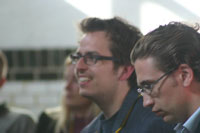 Thomas Madsen-Mygdal is the guy who made all this possible. Without him and the support of his family and friends, there would be no reboot conference.
Thomas Madsen-Mygdal is the guy who made all this possible. Without him and the support of his family and friends, there would be no reboot conference.
It was really great!
I’ve marked my calendar for reboot8 in June 2006.

